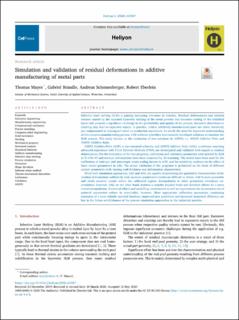Please use this identifier to cite or link to this item:
https://doi.org/10.21256/zhaw-20143| Publication type: | Article in scientific journal |
| Type of review: | Peer review (publication) |
| Title: | Simulation and validation of residual deformations in additive manufacturing of metal parts |
| Authors: | Mayer, Thomas Brändle, Gabriel Schönenberger, Andreas Eberlein, Robert |
| et. al: | No |
| DOI: | 10.1016/j.heliyon.2020.e03987 10.21256/zhaw-20143 |
| Published in: | Heliyon |
| Volume(Issue): | 6 |
| Issue: | 5 |
| Page(s): | e03987 |
| Issue Date: | May-2020 |
| Publisher / Ed. Institution: | Elsevier |
| ISSN: | 2405-8440 |
| Language: | English |
| Subjects: | Additive Fertigung; Simulation; Prozesssimulation; Verzug |
| Subject (DDC): | 670: Manufacturing |
| Abstract: | Selective laser melting (SLM) is gaining increasing relevance in industry. Residual deformations and internal stresses caused by the repeated layerwise melting of the metal powder and transient cooling of the solidified layers still presents a significant challenge to the profitability and quality of the process. Excessive distortions or cracking may lead to expensive rejects. In practice, critical additively manufactured parts are either iteratively pre-compensated or redesigned based on production experience. To satisfy the need for improved understanding of this complex manufacturing process, CAE software providers have recently developed solutions to simulate the SLM process. This study focuses on the evaluation of two solutions by ANSYS, i.e. ANSYS Additive Print and ANSYS Additive Suite. ANSYS Additive Print (AAP), a user-oriented software, and ANSYS Additive Suite (AAS), a software requiring advanced experience with Finite Element Methods (FEM), are investigated and validated with regard to residual deformations. For the evaluation of the two programs, calibration and validation geometries were printed by SLM in Ti–6Al–4V and residual deformations have been measured by 3D scanning. The results have been used for the calibration of isotropic and anisotropic strain scaling factors in AAP, and for sensitivity analyses on the effect of basic model parameters in AAS. The actual validation of the programs is performed on the basis of different sample geometries with varying wall thickness and deformation characteristic. While both simulation approaches, AAP and AAS, are capable of predicting the qualitative characteristics of the residual deformations sufficiently well, accurate quantitative results are difficult to obtain. AAP is more accessible and yields accurate results within the calibrated regime. Extrapolation to other geometries introduces uncertainties, however. AAS, on the other hand, features a sounder physical basis and therefore allows for a more robust extrapolation. Numerical efforts and modelling uncertainties as well as requirements for an extensive set of material parameters reduce its practicality, however. More appropriate calibration geometries, continuing extension of a more reliable material database, improved user guidelines and increased numerical efficiency are key in the future establishment of the process simulation approaches in the industrial practice. |
| URI: | https://digitalcollection.zhaw.ch/handle/11475/20143 |
| Fulltext version: | Published version |
| License (according to publishing contract): | CC BY-NC-ND 3.0: Attribution - Non commercial - No derivatives 3.0 Unported |
| Departement: | School of Engineering |
| Organisational Unit: | Institute of Mechanical Systems (IMES) |
| Appears in collections: | Publikationen School of Engineering |
Files in This Item:
| File | Description | Size | Format | |
|---|---|---|---|---|
| 2020_Mayer-etal_Residual-deformations-in-additive-manufacturing_Heliyon.pdf | 3.61 MB | Adobe PDF |  View/Open |
Show full item record
Mayer, T., Brändle, G., Schönenberger, A., & Eberlein, R. (2020). Simulation and validation of residual deformations in additive manufacturing of metal parts. Heliyon, 6(5), e03987. https://doi.org/10.1016/j.heliyon.2020.e03987
Mayer, T. et al. (2020) ‘Simulation and validation of residual deformations in additive manufacturing of metal parts’, Heliyon, 6(5), p. e03987. Available at: https://doi.org/10.1016/j.heliyon.2020.e03987.
T. Mayer, G. Brändle, A. Schönenberger, and R. Eberlein, “Simulation and validation of residual deformations in additive manufacturing of metal parts,” Heliyon, vol. 6, no. 5, p. e03987, May 2020, doi: 10.1016/j.heliyon.2020.e03987.
MAYER, Thomas, Gabriel BRÄNDLE, Andreas SCHÖNENBERGER und Robert EBERLEIN, 2020. Simulation and validation of residual deformations in additive manufacturing of metal parts. Heliyon. Mai 2020. Bd. 6, Nr. 5, S. e03987. DOI 10.1016/j.heliyon.2020.e03987
Mayer, Thomas, Gabriel Brändle, Andreas Schönenberger, and Robert Eberlein. 2020. “Simulation and Validation of Residual Deformations in Additive Manufacturing of Metal Parts.” Heliyon 6 (5): e03987. https://doi.org/10.1016/j.heliyon.2020.e03987.
Mayer, Thomas, et al. “Simulation and Validation of Residual Deformations in Additive Manufacturing of Metal Parts.” Heliyon, vol. 6, no. 5, May 2020, p. e03987, https://doi.org/10.1016/j.heliyon.2020.e03987.
Items in DSpace are protected by copyright, with all rights reserved, unless otherwise indicated.